Page 145 of 187
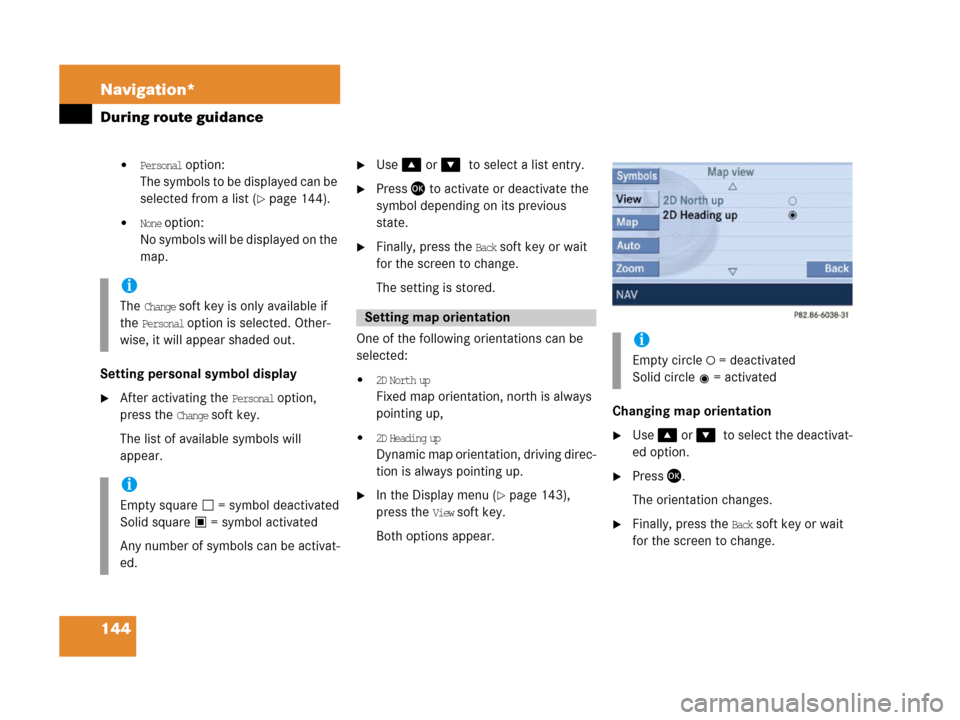
144 Navigation*
During route guidance
�Personal option:
The symbols to be displayed can be
selected from a list (
�page 144).
�None option:
No symbols will be displayed on the
map.
Setting personal symbol display
�After activating the Personal option,
press the
Change soft key.
The list of available symbols will
appear.
�Use % or &0to select a list entry.
�Press ' to activate or deactivate the
symbol depending on its previous
state.
�Finally, press the Back soft key or wait
for the screen to change.
The setting is stored.
One of the following orientations can be
selected:
�2D North up
Fixed map orientation, north is always
pointing up,
�2D Heading up
Dynamic map orientation, driving direc-
tion is always pointing up.
�In the Display menu (�page 143),
press the
View soft key.
Both options appear.Changing map orientation
�Use % or &0to select the deactivat-
ed option.
�Press'.
The orientation changes.
�Finally, press the Back soft key or wait
for the screen to change.
i
The Change soft key is only available if
the
Personal option is selected. Other-
wise, it will appear shaded out.
i
Empty square = symbol deactivated
Solid square = symbol activated
Any number of symbols can be activat-
ed.
Setting map orientation
i
Empty circle = deactivated
Solid circle = activated
Page 146 of 187
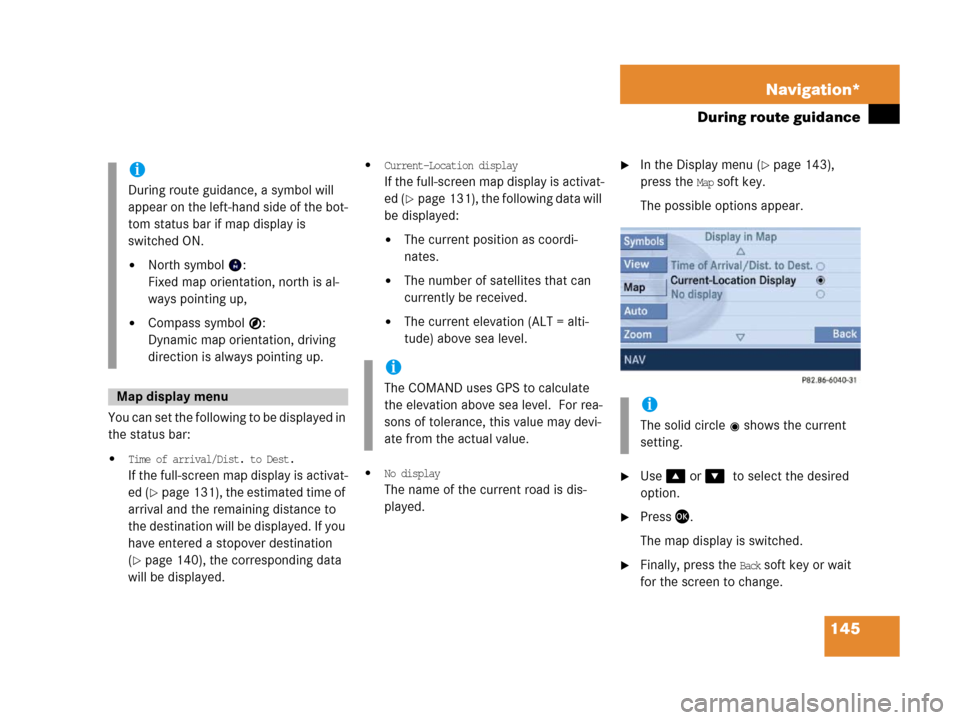
145 Navigation*
During route guidance
You can set the following to be displayed in
the status bar:
�Time of arrival/Dist. to Dest.
If the full-screen map display is activat-
ed (
�page 131), the estimated time of
arrival and the remaining distance to
the destination will be displayed. If you
have entered a stopover destination
(
�page 140), the corresponding data
will be displayed.
�Current-Location display
If the full-screen map display is activat-
ed (
�page 131), the following data will
be displayed:
�The current position as coordi-
nates.
�The number of satellites that can
currently be received.
�The current elevation (ALT = alti-
tude) above sea level.
�No display
The name of the current road is dis-
played.
�In the Display menu (�page 143),
press the
Map soft key.
The possible options appear.
�Use % or &0to select the desired
option.
�Press '.
The map display is switched.
�Finally, press the Back soft key or wait
for the screen to change.
i
During route guidance, a symbol will
appear on the left-hand side of the bot-
tom status bar if map display is
switched ON.
�North symbol :
Fixed map orientation, north is al-
ways pointing up,
�Compass symbol :
Dynamic map orientation, driving
direction is always pointing up.
Map display menu
i
The COMAND uses GPS to calculate
the elevation above sea level. For rea-
sons of tolerance, this value may devi-
ate from the actual value.
i
The solid circle shows the current
setting.
Page 147 of 187
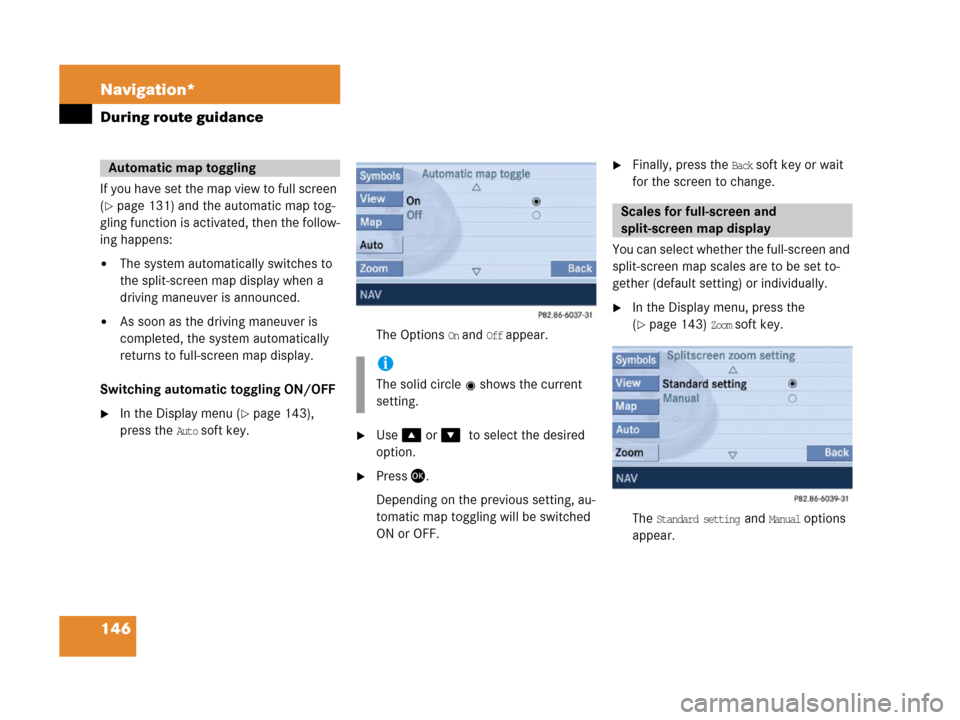
146 Navigation*
During route guidance
If you have set the map view to full screen
(
�page 131) and the automatic map tog-
gling function is activated, then the follow-
ing happens:
�The system automatically switches to
the split-screen map display when a
driving maneuver is announced.
�As soon as the driving maneuver is
completed, the system automatically
returns to full-screen map display.
Switching automatic toggling ON/OFF
�In the Display menu (�page 143),
press the
Auto soft key.The Options
On and Off appear.
�Use % or &0to select the desired
option.
�Press '.
Depending on the previous setting, au-
tomatic map toggling will be switched
ON or OFF.
�Finally, press the Back soft key or wait
for the screen to change.
You can select whether the full-screen and
split-screen map scales are to be set to-
gether (default setting) or individually.
�In the Display menu, press the
(
�page 143) Zoom soft key.
The
Standard setting and Manual options
appear.
Automatic map toggling
i
The solid circle shows the current
setting.
Scales for full-screen and
split-screen map display
Page 148 of 187
147 Navigation*
During route guidance
�Standard setting option:
The scales for full-screen and split-
screen map display are always
identical. Changing the scale
(
�page 130) on one map changes
the scale of the other.
�Manual option:
The scales can be different. Chang-
ing the scale on one map has no ef-
fect on the current scale of the
other map.
�Use % o r & t o s e l e c t t h e d e s i r e d o p -
tion.
�Press '.
Depending on the previous setting, the
Standard (identical scale) or Manual (indi-
vidual scale) option is activated.
�Finally, press the Back soft key or wait
for the screen to change.
i
The solid circle shows the current
setting.
Page 149 of 187
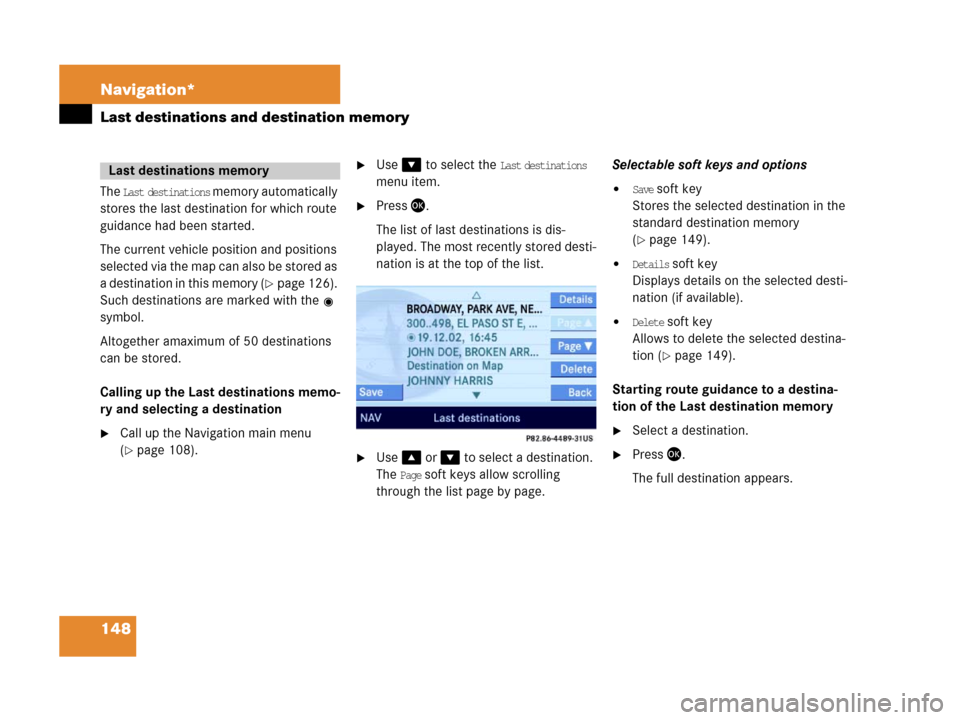
148 Navigation*
Last destinations and destination memory
The Last destinations memory automatically
stores the last destination for which route
guidance had been started.
The current vehicle position and positions
selected via the map can also be stored as
a destination in this memory (
�page 126).
Such destinations are marked with the
symbol.
Altogether amaximum of 50 destinations
can be stored.
Calling up the Last destinations memo-
ry and selecting a destination
�Call up the Navigation main menu
(
�page 108).
�Use& to select the Last destinations
menu item.
�Press '.
The list of last destinations is dis-
played. The most recently stored desti-
nation is at the top of the list.
�Use% or & to select a destination.
The
Page soft keys allow scrolling
through the list page by page.Selectable soft keys and options
�Save soft key
Stores the selected destination in the
standard destination memory
(
�page 149).
�Details soft key
Displays details on the selected desti-
nation (if available).
�Delete soft key
Allows to delete the selected destina-
tion (
�page 149).
Starting route guidance to a destina-
tion of the Last destination memory
�Select a destination.
�Press '.
The full destination appears.
Last destinations memory
Page 150 of 187
149 Navigation*
Last destinations and destination memory
�Press '0if you want to start route
guidance, otherwise press the
Back soft
key.
Deleting a destination from the last
destinations memory
�Select a destination (�page 148)
�Press the Delete soft key.
You are prompted to confirm whether
or not the destination is to be deleted.
�Use # to select the menu item Yes.
�Press '.
The destination is deleted.
Calling up the destination memory and
selecting a destination
�Call up the Navigation main menu
(
�page 108).
�Use % or & t o selec t t he Destination
memory
menu item.
�Press '.
The destination memory appears. This
is indicated by
Destination memory in the
status bar.
�Use#, $, %, or & to select the
desired entry.
Selectable soft keys and options
�Details soft key
Displays details on the selected desti-
nation (if available).
�Delete soft key
Allows to delete the selected destina-
tion (
�page 150).
Destination memory
Page 151 of 187
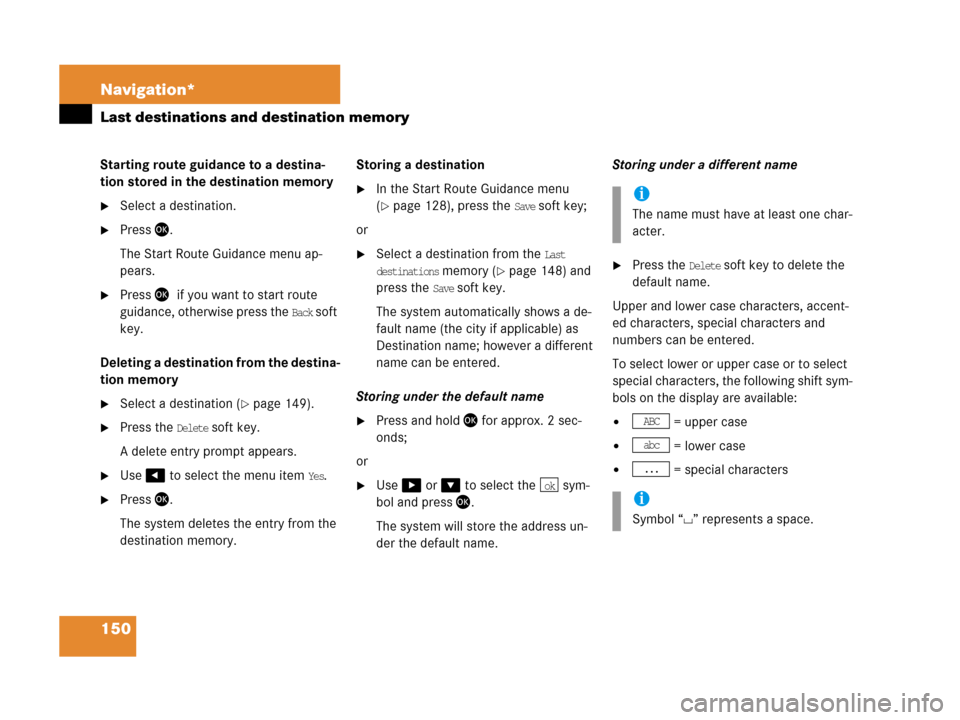
150 Navigation*
Last destinations and destination memory
Starting route guidance to a destina-
tion stored in the destination memory
�Select a destination.
�Press '.
The Start Route Guidance menu ap-
pears.
�Press '0if you want to start route
guidance, otherwise press the
Back soft
key.
D e l e t i n g a d e s t i n a t i o n f r o m t h e d e s t i n a -
tion memory
�Select a destination (�page 149).
�Press the Delete soft key.
A delete entry prompt appears.
�Use # to select the menu item Yes.
�Press '.
The system deletes the entry from the
destination memory.Storing a destination
�In the Start Route Guidance menu
(
�page 128), press the Save soft key;
or
�Select a destination from the Last
destinations memory (�page 148) and
press the
Save soft key.
The system automatically shows a de-
fault name (the city if applicable) as
Destination name; however a different
name can be entered.
Storing under the default name
�Press and hold ' for approx. 2 sec-
onds;
or
�Use$ or & to select the sym-
bol and press '.
The system will store the address un-
der the default name.Storing under a different name
�Press the Delete soft key to delete the
default name.
Upper and lower case characters, accent-
ed characters, special characters and
numbers can be entered.
To select lower or upper case or to select
special characters, the following shift sym-
bols on the display are available:
� = upper case
� = lower case
� = special characters
ok
i
The name must have at least one char-
acter.
i
Symbol “ ” represents a space.
ABC
abc
...
Page 154 of 187
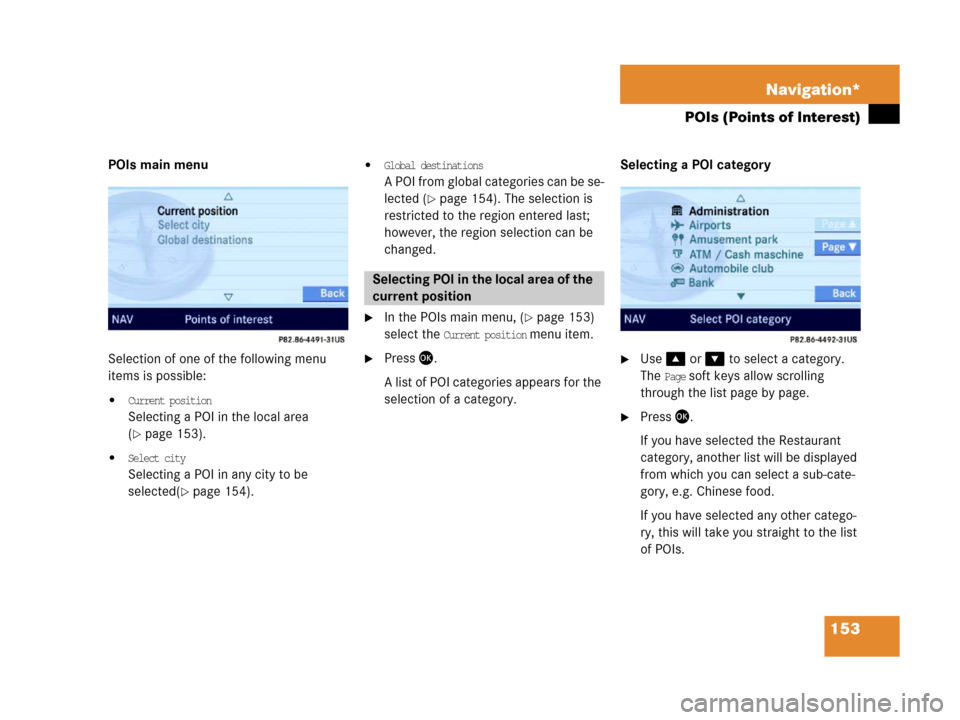
153 Navigation*
POIs (Points of Interest)
POIs main menu
Selection of one of the following menu
items is possible:
�Current position
Selecting a POI in the local area
(
�page 153).
�Select city
Selecting a POI in any city to be
selected(
�page 154).
�Global destinations
A POI from global categories can be se-
lected (
�page 154). The selection is
restricted to the region entered last;
however, the region selection can be
changed.
�In the POIs main menu, (�page 153)
select the
Current position menu item.
�Press '.
A list of POI categories appears for the
selection of a category.Selecting a POI category �Use% or & to select a category.
The
Page soft keys allow scrolling
through the list page by page.
�Press '.
If you have selected the Restaurant
category, another list will be displayed
from which you can select a sub-cate-
gory, e.g. Chinese food.
If you have selected any other catego-
ry, this will take you straight to the list
of POIs.
Selecting POI in the local area of the
current position